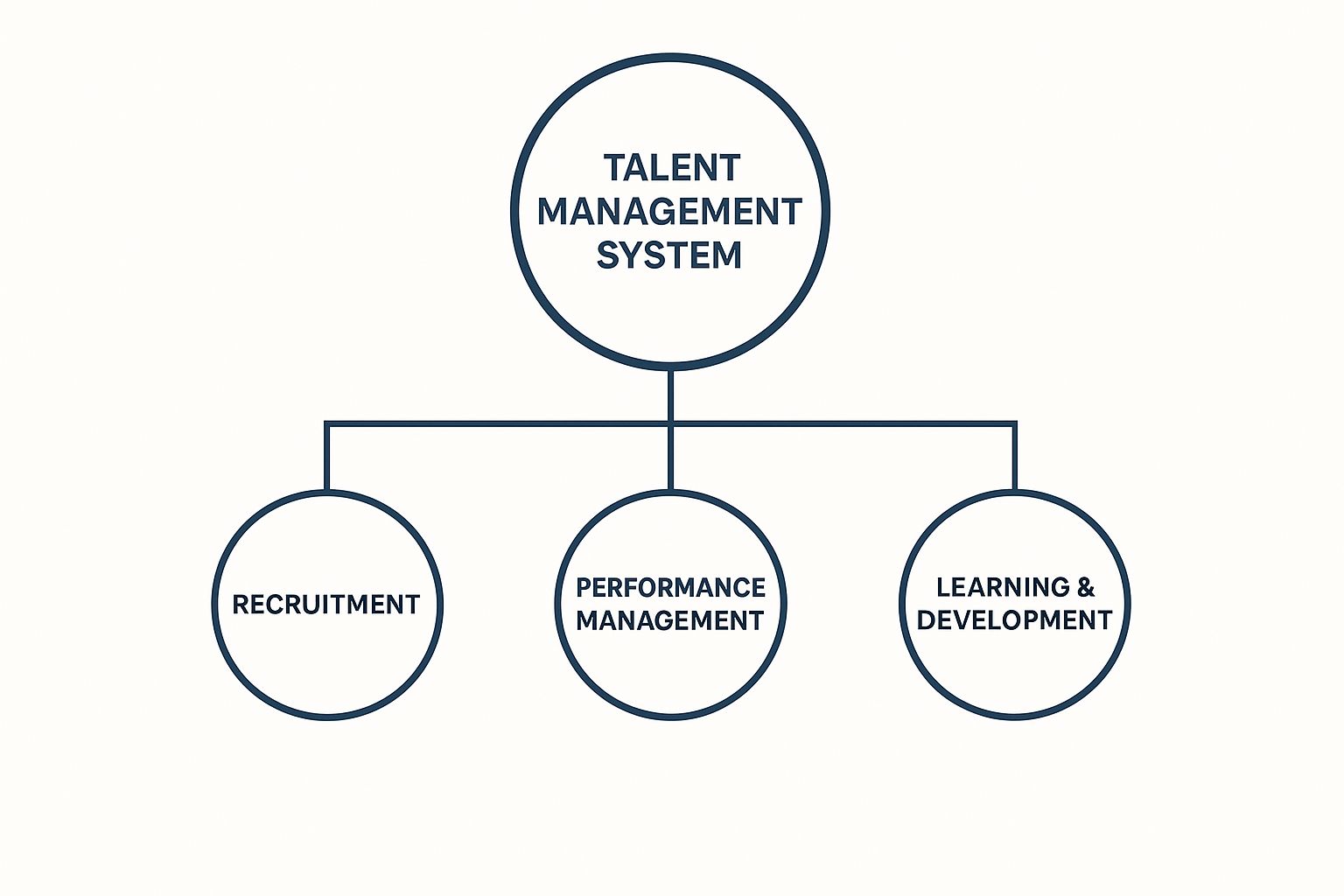Talent management system software is a set of connected tools that helps a company attract, grow, and keep its people. It pulls everything from recruiting and onboarding to performance reviews and training into a single, unified platform. This move turns HR from a collection of separate admin jobs into a smart, connected strategy. This guide provides actionable steps to help you choose, implement, and maximise the value of your system.

What Exactly Is a Talent Management System?

Think of a skilled orchestra conductor. With a score and a baton, they make sure every musician knows their part and plays in perfect harmony. In business, a talent management system is that score and baton. It coordinates every single stage of an employee's journey, from their first application to their last day, making sure everyone is contributing to the company's bigger goals.
Instead of wrestling with one spreadsheet for applicants, a separate tool for performance reviews, and yet another for training courses, this software brings it all under one roof. This connected approach gives you a complete picture of your entire workforce, tying individual potential directly to the company's success.
To put it simply, here’s a quick look at what this kind of software does.
Talent Management System Software at a Glance
| Component | Primary Function | Business Impact |
|---|---|---|
| Integrated Suite | Combines core HR functions like recruiting, onboarding, performance, and learning into one platform. | Moves HR from siloed administrative work to a unified, strategic function. |
| Data Centralisation | Gathers all employee data into a single source of truth. | Enables data-driven decisions on hiring, promotions, and succession planning. |
| Process Automation | Automates repetitive tasks like sending review reminders or tracking training progress. | Frees up HR teams to focus on high-value initiatives like employee engagement and development. |
| Strategic Alignment | Connects individual employee goals and performance with overall company objectives. | Ensures the entire workforce is pulling in the same direction, driving growth and success. |
This table shows how a talent management system isn't just a piece of software; it's a new way of thinking about how your people and your business grow together.
From Administrative Tasks to Strategic Insights
Without a central system, HR departments often get buried in manual, time-consuming tasks. The real power of a talent management system is its ability to automate that grind and deliver data you can actually use. It elevates HR from a reactive admin department to a proactive, strategic partner.
Actionable Step: Conduct a one-week audit of your HR team's time. Track hours spent on manual tasks like data entry, scheduling interviews, and chasing performance reviews. This data will build a powerful business case for automation.
This means you can finally:
- Identify your top performers and future leaders with data, not guesswork.
- Pinpoint skill gaps across teams and roll out training that actually fixes them.
- Improve employee retention by building clear, personalised career paths.
- Make hiring decisions based on solid candidate data instead of just a gut feeling.
A Look at the Dutch Market
The way companies adopt these systems often reflects their unique workforce strategies. In the Netherlands, for example, the fast-moving labour market has pushed companies to use both on-premise and cloud-based solutions to meet their specific security and customisation needs. On-premise systems still hold a big chunk of the market, largely because of the country's strict data protection standards. To dig deeper into these regional trends, you can read the full analysis on talent management software markets.
A talent management system isn't just about managing people; it's about building a framework where people can thrive and drive business growth. It aligns employee aspirations with company objectives, creating a powerful engine for success.
Ultimately, this software gives you the structure to manage your most valuable asset—your people—with the same care and insight you apply to your finances or operations.
Breaking Down the Core System Modules
To really get what a talent management system does, you need to look under the bonnet. It’s not one single, monolithic tool. Instead, think of it as a set of specialised modules that work together, a bit like different departments in a well-run company. Each part handles a specific stage of an employee's journey, making sure everything flows smoothly from their first application to becoming a key player on the team.
The diagram below shows how these core functions—Recruitment, Performance Management, and Learning & Development—act as the foundational pillars of a unified system.

This structure is what centralises all your key HR processes. It turns a bunch of disconnected activities into one cohesive strategy. Let's dig into what each of these modules actually does day-to-day.
Recruiting and Applicant Tracking
It all starts with finding the right people. The recruiting module is designed to automate the entire hiring marathon, from posting a job ad on multiple sites to getting interviews in the diary. The heart of this is the Applicant Tracking System (ATS), which acts like a digital command centre for every application, CV, and conversation with a candidate.
Practical Tip: When evaluating an ATS, check if you can create custom hiring workflows. A rigid, one-size-fits-all process for hiring a software engineer and a sales representative will frustrate your hiring managers.
This is a massive relief for hiring managers. Instead of drowning in endless email chains and messy spreadsheets, they get a clean, organised view of their candidate pipeline. It helps ensure a great applicant doesn't get lost in the shuffle and gives you the data to see which hiring channels are actually bringing in the best talent.
Employee Onboarding
Once a candidate says "yes," the onboarding module kicks in. This part of the system is about much more than just a first-day welcome pack. It’s designed to create a structured, welcoming experience that helps new hires feel part of the company culture and get up to speed faster.
Here’s what this module often automates:
- Sending out all the digital paperwork before their first day.
- Assigning a "buddy" or mentor from within their new team.
- Setting up a 30-60-90 day plan with clear goals and check-in points.
- Giving them instant access to essential training materials and company info.
A solid onboarding process pays off in a big way. In fact, companies with a standardised approach see 50% greater new-hire retention.
Performance Management
This is where the dreaded annual review finally gets a modern makeover. Instead of a once-a-year critique session, modern performance management modules turn it into a continuous cycle of feedback, goal-setting, and coaching. It becomes a tool for growth, not just judgment.
A manager can use it to set quarterly objectives that link directly to company goals, track progress as it happens, and give timely feedback right inside the platform. This creates a clear, transparent record of an employee’s contributions and where they might need support. By adding elements of recognition, you can also give motivation a serious boost. For more on that, you might want to check out our guide on how to gamify your employee productivity.
This module transforms performance reviews from a historical record of past mistakes into a forward-looking conversation about future growth and potential.
Learning and Development
The final piece of the puzzle is all about closing skill gaps and helping people grow their careers. The Learning and Development (L&D) module is like having your own internal corporate university. It can host everything from mandatory compliance courses to personalised learning paths for your next generation of leaders.
Actionable Step: Use your performance review data to identify the top three most requested training topics. Build your initial L&D offering around these to ensure immediate engagement and relevance.
Rather than just offering a library of generic courses, the system can suggest specific training based on someone's role, feedback from a performance review, or their own stated career goals. This proactive approach helps make sure your team’s skills stay sharp and aligned with where the business is headed. This is especially relevant in the Netherlands HR software market, where cloud platforms are increasingly using AI to improve everything from recruitment automation to employee engagement.
The Real-World Business Benefits of Adoption

When we move past a simple list of features, the true value of talent management system software starts to show up in real, measurable business results. Bringing this kind of technology into your company isn't just an upgrade for the HR department; it's a strategic move that directly helps your bottom line by changing how you find, grow, and keep your best people.
The most immediate benefit is a huge leap in operational efficiency. By automating all those manual, repetitive tasks, HR teams are freed from the daily grind of paperwork and administration. This gives them the breathing room to focus on what really matters—like strategic workforce planning and building a stronger company culture.
Improve Employee Retention and Engagement
High staff turnover is a silent profit killer, costing businesses a fortune in recruitment fees and training for new hires. A talent management system tackles this problem head-on by making career paths clear and visible to everyone. When your team can see a real future with the company, their loyalty and engagement go through the roof.
Actionable Example: Imagine a junior developer feels stagnant. The system flags that they haven't completed any new training in six months. Their manager is prompted to discuss career goals, then assigns a "Senior Developer Prep" learning path directly in the system, complete with mentorship check-ins. This proactive step can prevent a resignation.
By connecting performance feedback, learning opportunities, and career goals in one place, you create a culture where people feel valued and invested in, making them far more likely to stay.
Plus, ongoing performance feedback replaces the dreaded annual review. This keeps employees engaged and connected to company goals all year round, not just once a year.
Make Smarter Data-Driven Decisions
Guesswork has no place in a modern talent strategy. A talent management system software acts as a single source of truth, giving leaders the hard data they need to make smart decisions about their people. It’s a core piece of any digital HR transformation.
Take the challenge of talent scarcity in the Netherlands, a local issue that mirrors a global market trend which reached an estimated value of USD 14.56 billion. Dutch companies are increasingly relying on these systems to navigate skill gaps and make hybrid work models successful. You can learn more about the latest talent management software market trends to see the bigger picture.
Here’s how that data turns into practical action:
- Spot Future Leaders: Use performance and potential data to build a solid succession pipeline. You’ll always have someone ready to step up, ensuring the business keeps running smoothly.
- Find Skill Gaps: Analyse your team’s competencies to see a skills shortage coming. You can then launch a targeted training programme instead of spending thousands on external recruitment.
- Optimise Your Hiring: Track which recruitment channels bring in the best long-term hires. This lets you put your budget where it will actually have the biggest impact.
By turning raw employee data into actionable insights, a talent management system gives you the power to build a more resilient, skilled, and productive workforce.
How to Choose the Right Talent Management System
Picking the right talent management software can feel like a huge undertaking. But if you have a plan, the whole process gets a lot simpler. The real key is to think of it as choosing a partner, not just buying a product. You need a system that delivers value today and can grow with your organisation tomorrow.
The first move isn't to start booking demos—it's to look inwards. Before you see a single shiny feature, you need to get crystal clear on your organisation’s actual pain points and what you’re trying to achieve strategically. A little internal audit now will give you a solid roadmap for what to look for.
Start by Assessing Your Own Needs
First things first, map out your current processes. Where are the real bottlenecks? Are your hiring managers still wrestling with messy spreadsheets to track candidates? Is employee feedback a once-a-year scramble instead of a consistent conversation? Pinpointing these headaches helps you build a list of "must-have" features versus the "nice-to-haves."
Actionable Step: Create a simple survey for managers and HR staff with questions like, "What is the most time-consuming part of the hiring/review process?" and "If you could automate one task, what would it be?" Use the answers to build your requirements list.
This isn’t just an HR job, either. Get key people from other departments involved. Talk to IT about what it will take to integrate a new system. Chat with finance about the budget. Ask team leaders what their daily frustrations are. When you bring everyone to the table, you ensure the talent management system software you choose will solve real problems for the people who will actually use it.
One of the biggest mistakes is buying software based on an impressive feature list without first figuring out the core problems you need it to solve. A smart choice always, always starts with a deep understanding of your own needs.
Once you have that clear picture, you can start looking at vendors with a real sense of purpose.
Evaluate Vendors and Key Features
With your requirements list in hand, it’s time to start researching. Don't get distracted by slick marketing—stay focused on how each system’s features directly address the needs you've already identified. When you get into product demos, ask specific, targeted questions.
Here are a few critical questions to guide your thinking:
- Scalability: If we double in size over the next three years, will this system keep up or will we have to start all over?
- Integration: How easily does it plug into our current payroll and HRIS platforms? A system that creates new data silos is a step backwards, not forwards.
- User Experience: Is the interface actually intuitive? If it's clunky and hard to use, your employees won't touch it, and your adoption rates will tank.
- Support and Training: What kind of help do you offer when we're setting it up and after we go live? Good customer service isn't a bonus; it's non-negotiable.
Create a simple checklist to compare vendors side-by-side. It’s an organised way to make an objective, data-backed decision instead of just going with your gut after a persuasive sales pitch.
Feature Comparison Checklist for Talent Management Software
To make this even more practical, using a straightforward comparison table is a game-changer. It helps you keep track of how different solutions stack up against your most important criteria, all in one place. Here’s a basic checklist you can adapt for your own evaluation.
| Feature/Consideration | Vendor A | Vendor B | Vendor C |
|---|---|---|---|
| Recruitment & ATS Module | |||
| Performance Management | |||
| Learning & Development | |||
| Ease of Integration | |||
| Scalability for Growth | |||
| User-Friendliness | |||
| Pricing Model | |||
| Customer Support Rating |
By following this practical, step-by-step approach, you can navigate the selection process with confidence. It ensures you choose a talent management system that doesn't just fix today's problems but becomes a genuine strategic asset for years to come.
Implementing Your New System for Maximum Impact

Choosing the right talent management system software is a huge first step. But the real win comes from a smooth rollout that actually gets people to use it. A thoughtful implementation plan is what separates a powerful new tool from an expensive, ignored subscription.
Think of it like getting a new, more efficient machine for a factory floor. You wouldn't just drop it in place and walk away. You’d prepare the area, train the operators, and show them exactly how it makes their jobs easier. The same idea applies here, and it all starts with a solid plan.
Laying the Groundwork for a Smooth Transition
Before you hit the "go-live" button, a few key steps can prevent a lot of future chaos. This is all about preparation and setting your teams up to succeed from day one.
Clean Data Migration: Your new system is only as good as the data you put into it. Take the time to clean up existing employee records, performance histories, and training logs before moving them over. Getting rid of outdated or wrong information means you start with a reliable foundation.
Thoughtful System Configuration: Don't just stick with the default settings. Work with your vendor to set up workflows, permissions, and templates that match your company’s unique way of doing things. This customisation makes the software feel like it was built just for you.
Phased Rollout Strategy: Throwing the entire system at everyone at once can be completely overwhelming. A better approach is to roll it out in phases. Maybe start with a single module, like performance management, for just one department. This lets you gather feedback, iron out any kinks, and build a success story before the company-wide launch.
The goal of implementation isn't just to install software; it's to embed new, better habits into your organisation's daily work. Success is measured by adoption, not just installation.
Driving Adoption Through People and Communication
Technology on its own doesn't create change—people do. Getting your team on board requires clear communication that focuses on how the new system benefits them directly. This is where change management really comes into play.
A great first move is to find and empower a few internal champions. These are enthusiastic employees from different departments who can be the go-to people for their colleagues, answer questions, and build some positive buzz from the inside.
Next, make sure your communication answers the "what's in it for me?" question for every single user. For managers, it’s about easier goal tracking and less admin. For employees, it means a clearer view of their career path. Seeing how data transparency can clarify work patterns is a powerful motivator. You can discover how to optimise work patterns with data transparency and WhatPulse in our detailed guide.
Finally, deliver practical, role-based training. Generic, one-size-fits-all sessions are rarely effective. Instead, show managers exactly how to conduct a performance review in the new system and show employees how to find and sign up for training courses.
By following this simple roadmap, you can dodge the common implementation headaches and make sure your talent management system software starts delivering a real return on your investment right away.
Common Questions About Talent Management Software
When you're thinking about bringing new technology into your organisation, a lot of practical questions come up. Investing in something like talent management system software is a big step, so you need to be clear on what it does, what it costs, and if it’s even right for your business.
We hear a lot of the same questions from HR pros and business leaders. Most of them boil down to figuring out how this software is different from other HR tools and what it actually does for the business. Let's clear up a few of the most common points of confusion so you can move forward with confidence.
What Is the Difference Between a TMS and an HRIS?
It’s easy to mix these two up, but they’re built for different jobs.
Think of a Human Resources Information System (HRIS) as the digital filing cabinet for your team. It’s your system of record, handling the core administrative stuff—payroll, benefits, and basic employee data. Its main purpose is to manage the essential, transactional side of HR. An HRIS answers the question, "Who works here and how do we pay them?"
A Talent Management System (TMS), on the other hand, is all about strategic growth. It answers a different question: "How do we find, develop, and keep the best people to push our business forward?" It focuses on the employee’s entire journey, from recruiting and performance reviews to learning and succession planning. The two systems almost always work together, with the HRIS feeding the basic employee data to the TMS, which then uses it for its more strategic work.
How Much Does Talent Management Software Typically Cost?
The price for talent management system software can vary quite a bit, but it’s usually based on a "per employee, per month" (PEPM) model. This is actually great for businesses because it means the cost scales as your team grows.
Here’s a rough idea of what to expect:
- For small businesses (under 100 employees): You’re often looking at €4 to €14 per employee per month.
- For mid-sized companies (100-1,000 employees): The price usually lands somewhere between €9 and €19 per employee per month.
- For large enterprises (1,000+ employees): At this scale, pricing is nearly always a custom quote based on your specific needs and how many features you want.
Actionable Tip: When getting quotes, ask specifically about one-time implementation fees, training costs, and charges for ongoing support. These can significantly impact the total cost of ownership beyond the monthly subscription.
Many platforms also let you pay for modules separately. You might start with performance management and add the learning module later on as your company’s needs change.
The most important factor isn't just the price tag, but the return on investment. A system that improves retention by just a few percentage points can often pay for itself by reducing costly recruitment and onboarding expenses.
Can Small Businesses Truly Benefit from a System?
Absolutely. It used to be that only huge corporations used these tools, but modern cloud-based software has made powerful talent management affordable for just about everyone. For a small but growing company, a TMS can be a game-changer for setting up HR processes that can scale.
It helps small businesses go head-to-head with bigger companies for top talent by offering things like structured career paths and a polished onboarding process. As the team gets bigger, it also makes sure all that employee data stays organised and secure. For more specifics on that, you can read our FAQ regarding privacy and data collected to see how these systems handle sensitive information.
Ready to turn workforce data into actionable insights? WhatPulse provides a privacy-first analytics platform to help you understand how work happens, optimise software spend, and guide your teams toward greater focus and productivity. Discover WhatPulse Professional today.
Start a free trial